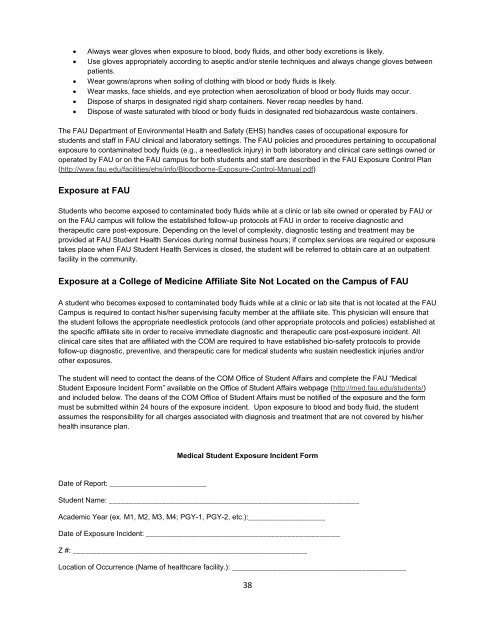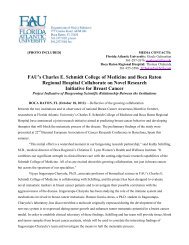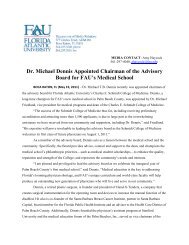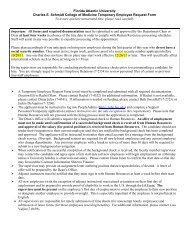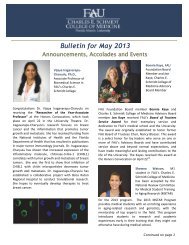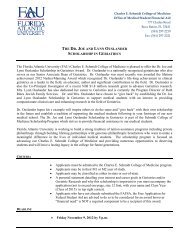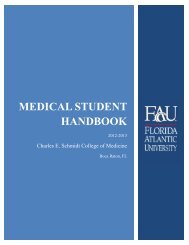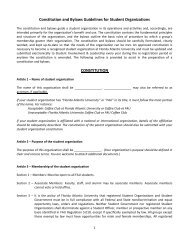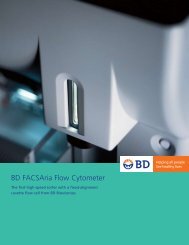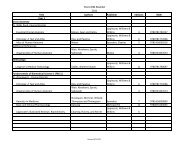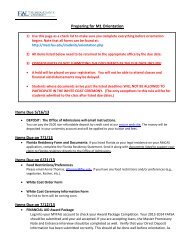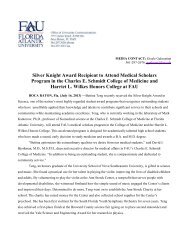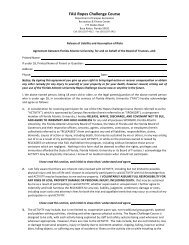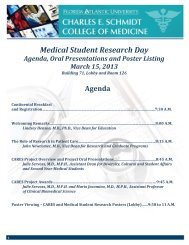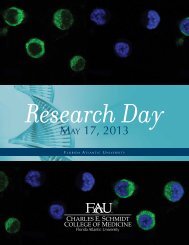Student Handbook - College of Medicine - Florida Atlantic University
Student Handbook - College of Medicine - Florida Atlantic University
Student Handbook - College of Medicine - Florida Atlantic University
Create successful ePaper yourself
Turn your PDF publications into a flip-book with our unique Google optimized e-Paper software.
N L K H F E D C AAlways wear gloves when exposure to blood, body fluids, and other body excretions is likely.Use gloves appropriately according to aseptic and/or sterile techniques and always change gloves betweenpatients.Wear gowns/aprons when soiling <strong>of</strong> clothing with blood or body fluids is likely.Wear masks, face shields, and eye protection when aerosolization <strong>of</strong> blood or body fluids may occur.Dispose <strong>of</strong> sharps in designated rigid sharp containers. Never recap needles by hand.Dispose <strong>of</strong> waste saturated with blood or body fluids in designated red biohazardous waste containers.The FAU Department <strong>of</strong> Environmental Health and Safety (EHS) handles cases <strong>of</strong> occupational exposure forstudents and staff in FAU clinical and laboratory settings. The FAU policies and procedures pertaining to occupationalexposure to contaminated body fluids (e.g., a needlestick injury) in both laboratory and clinical care settings owned oroperated by FAU or on the FAU campus for both students and staff are described in the FAU Exposure Control Plan(http://www.fau.edu/facilities/ehs/info/Bloodborne-Exposure-Control-Manual.pdf)Exposure at FAU<strong>Student</strong>s who become exposed to contaminated body fluids while at a clinic or lab site owned or operated by FAU oron the FAU campus will follow the established follow-up protocols at FAU in order to receive diagnostic andtherapeutic care post-exposure. Depending on the level <strong>of</strong> complexity, diagnostic testing and treatment may beprovided at FAU <strong>Student</strong> Health Services during normal business hours; if complex services are required or exposuretakes place when FAU <strong>Student</strong> Health Services is closed, the student will be referred to obtain care at an outpatientfacility in the community.Exposure at a <strong>College</strong> <strong>of</strong> <strong>Medicine</strong> Affiliate Site Not Located on the Campus <strong>of</strong> FAUA student who becomes exposed to contaminated body fluids while at a clinic or lab site that is not located at the FAUCampus is required to contact his/her supervising faculty member at the affiliate site. This physician will ensure thatthe student follows the appropriate needlestick protocols (and other appropriate protocols and policies) established atthe specific affiliate site in order to receive immediate diagnostic and therapeutic care post-exposure incident. Allclinical care sites that are affiliated with the COM are required to have established bio-safety protocols to providefollow-up diagnostic, preventive, and therapeutic care for medical students who sustain needlestick injuries and/orother exposures.The student will need to contact the deans <strong>of</strong> the COM Office <strong>of</strong> <strong>Student</strong> Affairs and complete the FAU “Medical<strong>Student</strong> Exposure Incident Form” available on the Office <strong>of</strong> <strong>Student</strong> Affairs webpage (http://med.fau.edu/students/)and included below. The deans <strong>of</strong> the COM Office <strong>of</strong> <strong>Student</strong> Affairs must be notified <strong>of</strong> the exposure and the formmust be submitted within 24 hours <strong>of</strong> the exposure incident. Upon exposure to blood and body fluid, the studentassumes the responsibility for all charges associated with diagnosis and treatment that are not covered by his/herhealth insurance plan.Medical <strong>Student</strong> Exposure Incident FormDate <strong>of</strong> Report: ________________________<strong>Student</strong> Name: ______________________________________________________________Academic Year (ex. M1, M2, M3, M4; PGY-1, PGY-2, etc.):___________________Date <strong>of</strong> Exposure Incident: ________________________________________________Z #: __________________________________________________________Location <strong>of</strong> Occurrence (Name <strong>of</strong> healthcare facility.): ___________________________________________38


